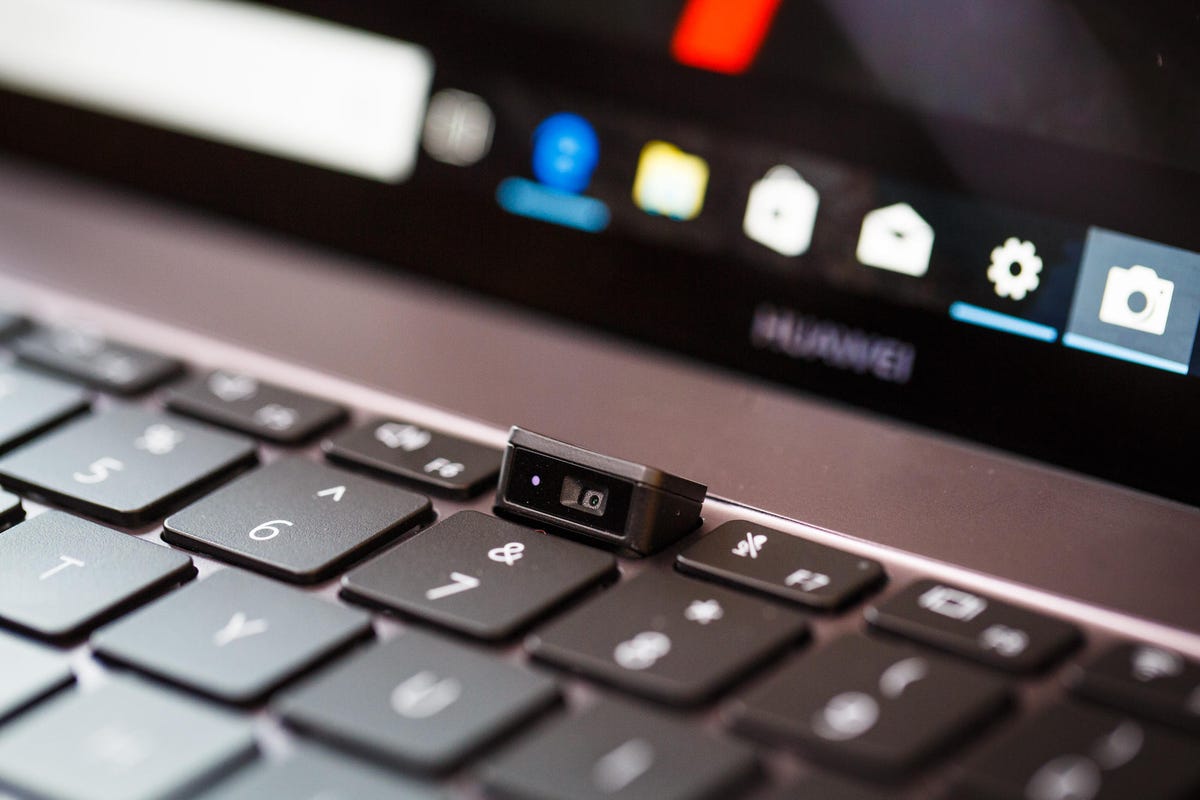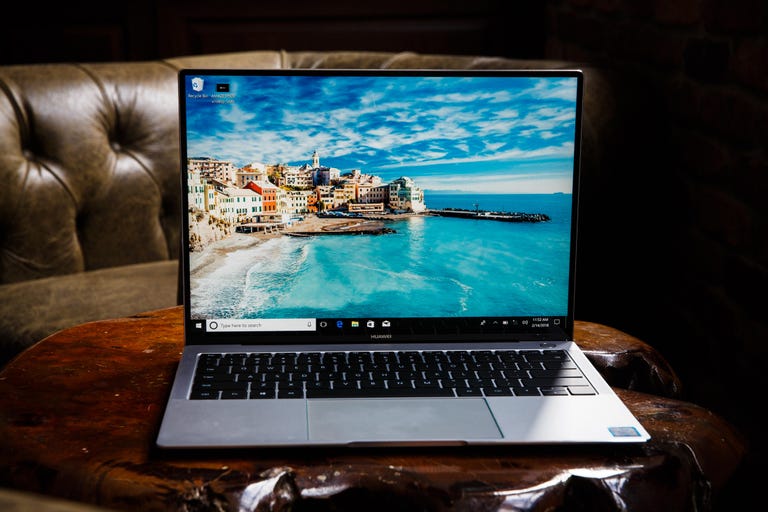 Why You Can Trust CNET
Why You Can Trust CNET Huawei MateBook X Pro review: The MateBook X Pro squeezes some big features into its little package
A great 14-inch display for its class and a discrete graphics processor give this slender MacBook alternative a lift above the crowd.
Huawei's slim little 14-inch clamshell laptop makes a big first impression that stands up over time. It boasts a bright, color-accurate screen and Nvidia MX150 discrete graphics in a slim, mostly well-designed body, making it an appealing Windows-based MacBook Pro alternative. As long as you're not counting on using the built-in webcam.
The Good
The Bad
The Bottom Line
Note that it's not quite a direct match to a MacBook Pro, at least for graphics work: The display is accurate, but it only covers the sRGB color space, as compared with Apple's Retina display with its much larger P3 color gamut. But for basic photo and video editing, that's good enough.
The system comes in two configurations: a Core i5-8250U with a 256GB SSD and 8GB memory for $1,200 (£1,300, AU$2,230) or our test configuration with a Core i7-8550U, 16GB memory and a 512GB SSD for $1,500 (£1,500, but with 8GB; not yet available in Australia, but probably around AU$2,500).
If all you're doing is typing and web surfing, you can get away with the cheaper model, though if that's all you're doing then the MateBook X Pro is overkill and you could save more money with something like the slightly heavier Dell XPS 13.
Huawei MateBook X Pro
| Price as reviewed | $1,499.99, £1,499.99 (with 8GB) |
|---|---|
| Display size/resolution | 13.9-inch 3,000x2,000 touch display |
| PC CPU | 1.8GHz Intel Core i7-8550U |
| PC memory | 16GB DDR3 SDRAM |
| Graphics | 2MB Nvidia GeForce MX150 |
| Storage | 512GB SSD |
| Ports | Headphone jack, 1 x USB Type A, 2 x USB-C (1 x Thunderbolt 3) |
| Networking | Intel Dual-Band Wireless-AC 8275, Bluetooth 4.2 |
| Operating system | Windows 10 Home (64-bit) |
| Weight | 2.9 lbs/1.3kg |
From the ridiculous to the sublime
Let's just get these two design abominations out of the way: the gimmicky pop-up webcam and the awful AC adapter plug that takes up the space of three outlets. While it's great that you can hide the camera for extra privacy, the angle and location make it unusable. Of course, you can work around both problems with a third-party 65W USB-C charger and external webcam.

Who thought this was a good idea? It's actually worse than Dell's notorious up-nose camera placement.
This is the view of you the webcam shows. If the notebook is farther away you just get the up-nose perspective.
But the rest of the design is almost ideal given the trade-offs it needs to make between size, heat dissipation needs and connections. With only two USB-C ports and one USB-A, you're going to have to go with a dock or dongle.
One of the highlights is the 13.9-inch touchscreen. The resolution of 3,000x2,000 pixels means it has an excellent pixel density of 271 ppi for sharp text, lines and detail resolution. While the LTPS touchscreen only covers 100 percent of sRGB -- 73 percent of Adobe RGB and P3 as tested -- it delivers excellent color accuracy for its class and a peak brightness of 544 nits, though not at the same time and only if you turn off the default adaptive brightness setting. The white point is a little high at about 6,800K, but that's very good for a display that's not designed for color-critical work.
Because of its 3:2 aspect ratio, though, movies and games will usually appear letterboxed, and it's relatively reflective, like many of its competitors.
Slim and steady
It has a sensible keyboard layout with big chiclet keys. The keycaps are a little slippery, but they have just enough travel and feedback for comfortable touch typing, and the keyboard's supposedly spillproof. The Windows Precision touchpad is big and responsive with clickable areas; I find it a bit too sensitive even set to low, but it's pretty typical in that respect. Huawei integrated the fingerprint sensor into the power button, one of the latest trends in laptop design.
The build quality looks and feels premium, for the most part. The top and bottom covers are aluminum, but the keyboard surround area feels a bit plasticky. That keeps it from getting too hot, though, and helps reduce the weight.
Quad speakers sit on either side of the keyboard, and they can get pretty loud for such a small laptop -- I've tested huge gaming laptops with lesser volume. Overall sound quality is quite good, as long as you don't pump up the volume past about 80 percent. The laptop supports Dolby Atmos, and Atmos delivers moderately good surround for its size; you shouldn't expect too much from it, though.
The Nvidia MX150 GPU gives you a nice little performance bump over Intel 's integrated graphics for playing the occasional platformer and for low-volume photo editing in addition to the usual web surfing and Netflixathons, but like most ultrathin laptops the MateBook X Pro uses the slower, lower-power version of the chip (1D12) running at 936MHz rather than the faster 1,468MHz version (1D10). The slower chip ostensibly delivers better battery life, but at 9 hours the laptop's life is only about average for its class.
Geekbench 4 (multicore)
Streaming video playback battery drain test
3DMark Fire Strike Ultra
Cinebench R15 OpenGL
Cinebench R15 CPU (multicore)
System configurations
| Asus ZenBook Flip 14 (US461U) | Microsoft Windows 10 Home (64-bit); 1.8GHz Intel Core i7-8550U; 16GB DDR3 SDRAM 2,133MHz; 2GB Nvidia GeForce MX150 Graphics; 512GB SSD |
|---|---|
| Dell XPS 13 (late 2017) | Microsoft Windows 10 Home (64-bit); 1.8GHz Intel Core i7-8550U; 8GB DDR4 SDRAM 1,866MHz; 128MB (dedicated) Intel HD Graphics 620; 256GB SSD |
| Huawei MateBook X Pro | Microsoft Windows 10 Home (64-bit); 1.8GHz Intel Core i7-8550U; 16GB DDR3 SDRAM 2,133MHz; 2GB Nvidia GeForce MX150 Graphics; 512GB SSD |


